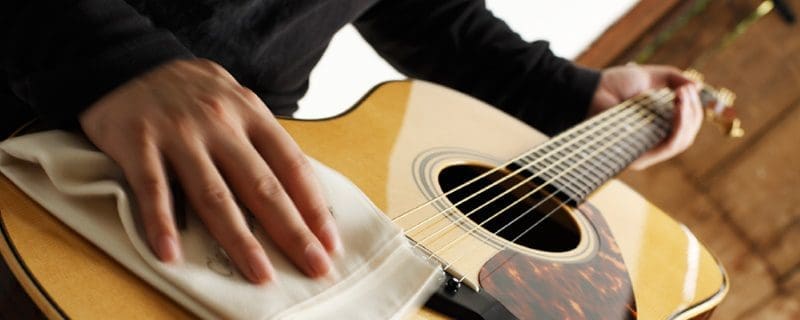Last update 5/2/2024
Guitar Maintenance, what is it exactly? The dictionary (the one we use, anyway) has several definitions for the word ‘maintenance.’ How to maintain your guitar is defined as ‘the upkeep of property or equipment.’ You need to take care of your guitar.
How to Maintain Your Guitar
Table of contents
But what exactly does it mean to perform proper guitar maintenance? And is it something you can do by yourself? It means quite a few things actually, and yes – you can without spending a ton of time or money. Let’s briefly examine some tips to keep your guitar in the best possible condition.
This comprehensive guide will explore the art and science of maintaining your guitar. From cleaning and tuning to more intricate tasks like adjusting the truss rod or setting the action, we’ll explore every facet of guitar maintenance.
Understanding the anatomy of your instrument is the first step toward ensuring its longevity and optimal performance. Moreover, we’ll discuss the significance of environmental factors on your guitar’s health. Temperature, humidity, and storage conditions play a pivotal role in preserving your instrument’s tone and structural integrity.
Basic Guitar Maintenance
Keeping a relatively fresh set of strings on your guitar does a couple of things. First off, it helps to keep dirt and grime from building up on your fretboard (more on this one a little later)
Secondly, it will keep your tone in tip-top shape as strings tend to lose their brightness over time, regardless of how much you may wipe your guitar down after you play.
Yeah, some guitar players may like the thicker and warmer sound from a set of strings that have some playing time on them, but there will come a point where all of the bite and life will end up missing from your sound.
Clean things up
Whether you are playing for your enjoyment in your guitar practice space or dripping sweat all over your ax from playing some intense gigs, maintaining your guitar’s finish by giving your guitar a good wipe down and cleaning is imperative.
I’ve always wanted to smash a guitar over someone’s head. You just can’t do that with a piano – Elton John
That means the whole instrument – body, neck, and headstock. Look at it this way – when you take a bath or shower, you typically wash your entire body, not just part of it, right? The same should go for your guitar!


Most music stores sell cheap guitar cloths (made of either flannel or microfiber) that will take all of the grime and smudges off the finish and keep your guitar looking (and feeling) as if it was fresh off the rack.
Also – going back to the ‘dirt and grime on the fretboard’ thing I mentioned earlier, make sure you take the time to clean your fretboard each time you change your guitar strings. You may not notice how much crud can build up in between your frets, but over time, it can get pretty bad if you don’t keep it clean. Occasionally, using a good quality fretboard cleaner and conditioner is also a good idea.
Humidity matters!
Guitars are (for most models) constructed almost entirely from wood. Wood is a natural and porous material that can be extremely sensitive to changes in relative humidity.
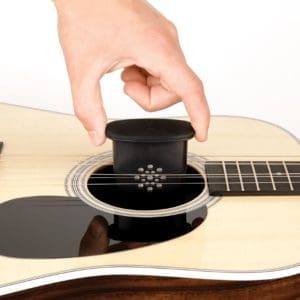

Acoustic Guitar Maintenance Tips
Acoustic guitar types are more sensitive to humidity than solid-body electric types due to the thin wood construction of the body. If an acoustic (especially one with a solid wood top) is left too long in a dry environment, it’s only a matter of time before you get warping and shrinking – even to the point of complete cracks in the top.
That’s not to say that electrics can’t feel the effect. You can tell if an electric guitar is getting too dry when you start to feel the edges of the frets (due to the neck slightly shrinking), or tuning stability and inconsistent playing action.
So what can you do? The easiest way is to use a guitar humidifier in your case or gig bag. There are several types, from simple plastic housings that hold a damp sponge (which will need to be re-dampened every so often) or more advanced solutions such as specially designed packages that allow for the transfer of humidity without much maintenance on your end.
And speaking of cases.
Case in point
It doesn’t matter if your guitar is your very first one or if it’s a top-of-the-line professional model. Good guitar maintenance is all about taking care of your investment regardless of how much it costs. The best way to do that is to have a top-quality hardshell case.
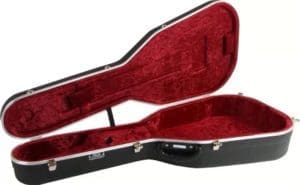

A good case will protect your guitar from the environment (using a humidifier, remember?), and it’s a great way to keep it safe when you’re not playing. Many cases also have small compartments to store the must-have guitar accessories that every guitar player needs handy (such as extra strings, picks, a tuner, a capo, etc.).
Gig bags can be decent substitutes, but they typically aren’t as rugged. Some manufacturers make ‘soft’ bags with hard inserts in the top and sides; they may not be as robust as a hardshell case, but they do offer a higher level of protection than a soft cloth bag (which, by the way, is much better than using nothing at all).
Stand by your…guitar?
Guitar maintenance boils down to good old common sense. There are countless horror stories of someone taking a break and leaning their guitar against the wall, amp, the furniture. You get the picture.


And…………you can probably also picture what happens next.
There’s nothing more sickening than seeing your prized guitar slowly crash to the floor when you’re several feet away, and no matter how fast you run to try and save it – it’s too late. You may get lucky and get a few scuffs or scratches or run into significant damage.
The moral of the story: Guitar stands are cheap. Buy one. Use it.
All the time.
Proper Guitar Maintenance means checking your temperature.
Guitars don’t deal well with humidity levels that are too high or low. A common scenario is leaving a guitar in the car without a second thought. Temperatures can reach dangerous levels in a car left in the sun. Yes, this falls into the ‘common sense realm again, but you may be surprised how many people neglect their guitars in this regard.
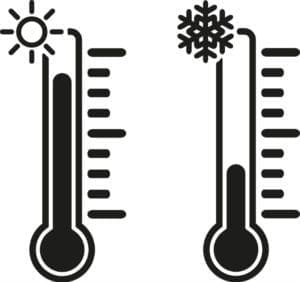

Extreme temperatures are another situation where acoustics may be more prone to damage due to their construction. Too cold certainly isn’t right, as taking one out of a case that’s been left out in the car during winter (and not letting it warm up first) can cause all kinds of wrong things to happen.
The heat is also bad. Real bad. Acoustics are typically held together with glues and adhesives, and if yours is left in a hot car in the middle of summer, then that glue can tend to soften up, leading to even more kinds of wrong things happening.
You wouldn’t leave your kids or dog in extreme temps, right? Give your guitar the same respect and consideration!
Guitar Maintenance Checklist:
Make it a habit to keep your guitar in good shape by following an essential checklist regularly; you can maintain your guitar’s playability and sound quality consistently.
- Basic guitar maintenance checklist
- Cleaning and polishing the guitar
- Change the strings regularly.
- Check for cracks or any damage to the guitar (acoustics in particular)
- Are the tuning keys working properly
- Checking and adjusting the action if needed. (string height)
- Are the pickup selectors and pots( Volume and tone knobs) working correctly?
- Are the frets of the guitar showing any signs of wear?
- Check the neck and truss rod, inspect the electronics (for electric guitars), and verify the intonation. (see guitar setup)
- Is there any string buzz? (see guitar setup)
Tools for Guitar Maintenance
Having the right tools and equipment is crucial for effective guitar maintenance. Essential tools should include various wrenches, screwdrivers, string cutters, and guitar polish. Additionally, specialized tools like nut slot files, fret crowning files, and radius gauges are essential for more advanced setups and repairs. Investing in quality maintenance equipment ensures better results and protects your guitar from damage when doing maintenance tasks.
The right tools are crucial for successful guitar maintenance and keeping your guitar/s tip top. Essential tools include:
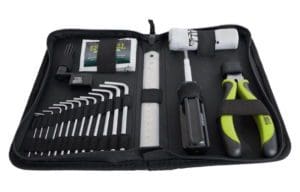

- Various wrenches for adjusting the truss rod and bridge.
- Screwdrivers for tightening screws.
- A string cutter for changing strings.
More specialized tools, such as fret files and radius gauges, are helpful for advanced setups and fretwork. Building a tool kit tailored to your guitar’s needs will make maintenance tasks more efficient and effective.
A complete setup for the guitar
A guitar setup includes adjusting various components to ensure optimal playability, intonation, and tone. Yeh, It’s a crucial maintenance procedure that helps the instrument perform at its best and makes it more comfortable and enjoyable to play. A well-executed guitar setup can significantly improve your guitar’s overall performance and sound.
How often should I do a setup? Well, that depends on many variables, mainly temperature and humidity (particularly for acoustics). However, a setup can be a simple check to ensure the guitar’s playability is free of issues. A few common ones are string buzz or the strings are hard to fret; tonality may sound off.
Guitar Maintenance Fret Buzz
We won’t say, “Don’t fret, but it’s tempting.” Fret buzz is a common issue that guitarists encounter and can result from various factors. The unwanted buzzing or rattling sound is produced when a string vibrates against a fret. Fret buzz can be caused by improper neck relief, incorrect string height, or uneven frets. Identifying the root cause of fret buzz is crucial to addressing the issue effectively.
Proper maintenance should always include a truss rod check and adjustment when required, eliminating or minimizing fret buzz and restoring your guitar’s playability.
Here are some of the critical aspects of a guitar setup:
- Neck Adjustment: The neck of the guitar is adjusted to achieve the proper amount of bow or relief. Too much bow can cause high action and string buzzing, while too little bow can lead to fretting buzz in the middle of the neck. The truss rod inside the neck is used to make these adjustments.
- Action Height: The action refers to the distance between the strings and the fretboard. Lowering the action makes the guitar easier to play while raising it can help reduce string buzz and increase sustain. This adjustment is done by raising or lowering the bridge saddles or the nut.
- Intonation: Intonation ensures that the guitar plays in tune across the entire fretboard. It involves adjusting each string’s length to match the instrument’s scale length. Proper intonation ensures that each fret produces the correct pitch.
- Nut Adjustment: The nut at the top of the fretboard supports the strings and maintains their spacing. Properly shaping and filing the nut slots ensures smooth string action and prevents binding or buzzing.
- Bridge Adjustment: The guitar’s bridge holds the strings in place at the body end. Adjusting the individual saddle heights helps to set the intonation and action of each string.
- Pickup Height: For guitars with magnetic pickups, the distance between the pickups and the strings affects the overall tone and volume. Adjusting the pickup height can fine-tune the guitar’s sound.
- Cleaning and Lubrication: During a setup, it’s common to clean the fretboard, polish the frets, and lubricate any moving parts, such as the tuning machines and tremolo systems.
Professional luthiers or guitar technicians usually perform guitar setups, but many guitar players learn to do basic setups themselves, as it is an essential skill for any guitarist. A well-set-up guitar will feel more comfortable to play and help you get the best possible sound out of your instrument.
How to Maintain Your Guitar Books
For those of you who want to delve deeper into electric guitar maintenance, there are excellent books about guitars on Amazon that are very helpful.
Best Books on Electric Guitar Maintenance
These books cover everything from basic setups to more advanced repairs, providing invaluable knowledge to guitar enthusiasts at any skill level.
Electric guitar maintenance
Recommended books for acoustic guitar maintenance
Acoustic guitar maintenance
Guitar Maintenance and Repair Book
A dedicated book on the subject can be invaluable for those interested in comprehensive guitar maintenance and repair. “Guitar Player Repair Guide” by Dan Erlewine is a highly regarded book that covers everything from essential maintenance to complex repairs. This book provides step-by-step instructions and illustrations to guide readers through various maintenance and repair tasks, making it suitable for beginners and experienced players.
The Guitar Player Repair Guide
Guitar Maintenance Accessories
Beyond the essential tools, various guitar maintenance accessories can benefit beginners and experienced players. Capos help change tuning keys and experiment with different fret positions. A reliable electronic tuner is essential for accurate tuning, and picks of various thicknesses provide other tonal options. A selection of accessories allows you to experiment with different playing styles and techniques.
Guitar maintenance, in conclusion
Overall, performing maintenance for your guitar is a pretty simple thing to do. The right guitar accessories (such as a case or a guitar stand) can be relatively inexpensive, and a good part of taking proper care of your instrument will cost you nothing except spending a few minutes of your time.
By following the straightforward steps outlined in this article—regular cleaning, proper string changing, humidity control, neck adjustment, and safe storage—you can protect your investment and enjoy a better playing experience.
Remember that routine maintenance is not just about preserving the guitar’s appearance; it also plays a critical role in its performance and your overall satisfaction as a player.
Your guitar is not just a piece of wood and strings; it’s a creative partner that deserves your attention and respect.
Sum it up like this – take care of your guitar, and it will take care of you.
Transparency disclosure: Some of the links in this post are affiliate links, meaning that I may earn a commission if you click on a link and make a purchase. This commission comes at no extra cost to you. We only recommend products and services that I believe are helpful and valuable, and we never let the potential for a commission influence our recommendations.

